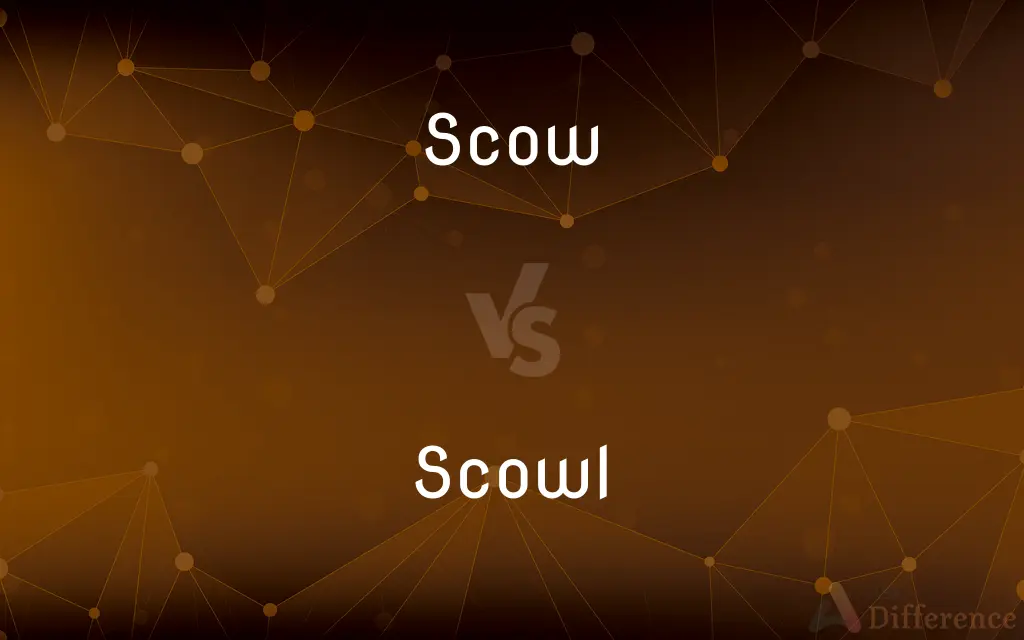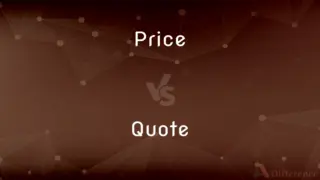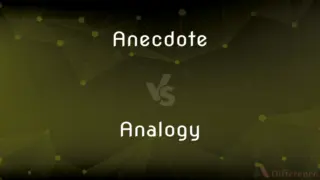Scow vs. Scowl — What's the Difference?
By Tayyaba Rehman & Maham Liaqat — Updated on April 23, 2024
Scow refers to a flat-bottomed boat with square ends, used mainly for transporting goods on calm waters, while a scowl is a type of facial expression characterized by a frown or angry look.

Difference Between Scow and Scowl
Table of Contents
ADVERTISEMENT
Key Differences
A scow is a type of boat designed for stability and large cargo capacity on inland waters and harbors, featuring a flat bottom and square ends. On the other hand, a scowl is a facial expression denoting displeasure, anger, or annoyance, often involving furrowed eyebrows and a frown.
Scows are primarily utilitarian, often used in calm, shallow waters for tasks such as carrying bulk cargo or serving as barges. Whereas scowls are universal human expressions that communicate negative emotions, transcending cultural and linguistic barriers.
The design of a scow allows for easy loading and unloading of goods, making it ideal for short transport routes along rivers and canals. In contrast, a scowl can be a quick, involuntary reaction to immediate circumstances, requiring no specific setting or preparation.
While scows play a crucial role in certain types of maritime industries, especially in construction and dredging operations, scowls are more associated with personal interactions and are often used to express dissatisfaction or disapproval.
Scows are part of a specific vocabulary related to naval architecture and maritime commerce, often discussed in the context of their practical applications. Meanwhile, scowls are studied in the fields of psychology and communication, highlighting their role in non-verbal human interaction.
ADVERTISEMENT
Comparison Chart
Definition
A flat-bottomed boat with square ends, used mainly for transporting goods.
A facial expression of displeasure or anger.
Usage
In maritime transport and industry.
In personal and social communication.
Construction
Made of wood or metal, designed for stability in calm waters.
Not applicable, as it is a human expression.
Related Fields
Naval architecture, maritime logistics.
Psychology, social communication.
Common Setting
Rivers, canals, and near shorelines.
Any social or personal interaction.
Compare with Definitions
Scow
A large flat-bottomed boat with broad square ends used chiefly for transporting bulk material.
The scow moved slowly down the river, laden with gravel and sand.
Scowl
A facial expression of displeasure characterized by a frown and furrowed eyebrows.
His scowl deepened as he read the disappointing news.
Scow
A large flat-bottomed vessel used in shallow and calm waters.
The fisherman preferred a scow for navigating the shallow marshes.
Scowl
To have a gloomy or threatening look.
The sky scowled with dark clouds before the storm.
Scow
A barge used for carrying garbage or dredge material.
The city uses a scow to transport waste to the treatment facility.
Scowl
To express anger or disapproval through one's facial expression.
She scowled at the unruly child.
Scow
A sailing dinghy with a flat bottom and square ends.
They raced their scow at the local sailing club.
Scowl
To frown angrily or sulkily.
He scowled when he saw the mess in the kitchen.
Scow
A flat-bottomed boat used as a floating platform.
The workers stood on the scow while repairing the bridge.
Scowl
A look conveying annoyance or irritation.
The teacher gave the latecomer a scowl.
Scow
A scow is a type of flat-bottomed barge. Some scows are rigged as sailing scows.
Scowl
An angry or bad-tempered expression
She stamped into the room with a scowl on her face
Scow
A large flatbottom boat with square ends, used chiefly for transporting freight.
Scowl
Frown in an angry or bad-tempered way
She scowled at him defiantly
Scow
A large flat-bottomed boat, having broad, square ends.
Scowl
To wrinkle or contract the brow as an expression of anger or disapproval.
Scow
(transitive) To transport in a scow.
Scowl
To express (displeasure, for example) with a frowning facial expression.
Scow
A large flat-bottomed boat, having broad, square ends.
Scowl
A look of anger or frowning disapproval.
Scow
To transport in a scow.
Scowl
The wrinkling of the brows or face in frowning; the expression of displeasure, sullenness, or discontent in the countenance; an angry frown.
She made a scowl.
Scow
Any of various flat-bottomed boats with sloping ends
Scowl
(by extension) Gloom; dark or threatening aspect.
Scow
A barge carrying bulk materials in an open hold
Scowl
(intransitive) To wrinkle the brows, as in frowning or displeasure; to put on a frowning look; to look sour, sullen, severe, or angry.
Scowl
To look gloomy, dark, or threatening; to lower.
Scowl
(transitive) To look at or repel with a scowl or a frown.
To scowl a rival into submission
Scowl
(transitive) To express by a scowl.
To scowl defiance
Scowl
To wrinkle the brows, as in frowning or displeasure; to put on a frowning look; to look sour, sullen, severe, or angry.
She scowled and frowned with froward countenance.
Scowl
Hence, to look gloomy, dark, or threatening; to lower.
Scowl
To look at or repel with a scowl or a frown.
Scowl
To express by a scowl; as, to scowl defiance.
Scowl
The wrinkling of the brows or face in frowing; the expression of displeasure, sullenness, or discontent in the countenance; an angry frown.
With solemn phiz, and critic scowl.
Scowl
Hence, gloom; dark or threatening aspect.
A ruddy storm, whose scowlMade heaven's radiant face look foul.
Scowl
A facial expression of dislike or displeasure
Scowl
Frown with displeasure
Common Curiosities
Can scows be used in rough waters?
Typically, scows are not suitable for rough waters due to their flat bottoms and broad shapes.
What does a scowl typically indicate about a person's mood?
A scowl usually indicates anger, displeasure, or irritation.
Is scowling a universal expression?
Yes, scowling is considered a universal expression of displeasure across different cultures.
What is the primary use of a scow?
Scows are mainly used for transporting bulk materials on calm inland waters.
How does the construction of a scow support its function?
The flat bottom and square ends of a scow make it stable and easy to load or unload, which is ideal for transport in shallow waters.
Can scowling be controlled?
People can learn to control their scowling as part of managing their non-verbal communication.
What materials are scows typically made from?
Scows are usually made from materials like wood or metal.
Is it possible to mistake other facial expressions for a scowl?
Yes, similar expressions like frowning or grimacing can sometimes be mistaken for a scowl.
Are scows still in use today?
Yes, scows are still used, particularly in industries like construction and dredging.
What psychological effect can a scowl have on others?
A scowl can communicate disapproval or threat, influencing others' perceptions and potentially escalating conflicts.
Share Your Discovery

Previous Comparison
Price vs. Quote
Next Comparison
Anecdote vs. AnalogyAuthor Spotlight
Written by
Tayyaba RehmanTayyaba Rehman is a distinguished writer, currently serving as a primary contributor to askdifference.com. As a researcher in semantics and etymology, Tayyaba's passion for the complexity of languages and their distinctions has found a perfect home on the platform. Tayyaba delves into the intricacies of language, distinguishing between commonly confused words and phrases, thereby providing clarity for readers worldwide.
Co-written by
Maham Liaqat













































